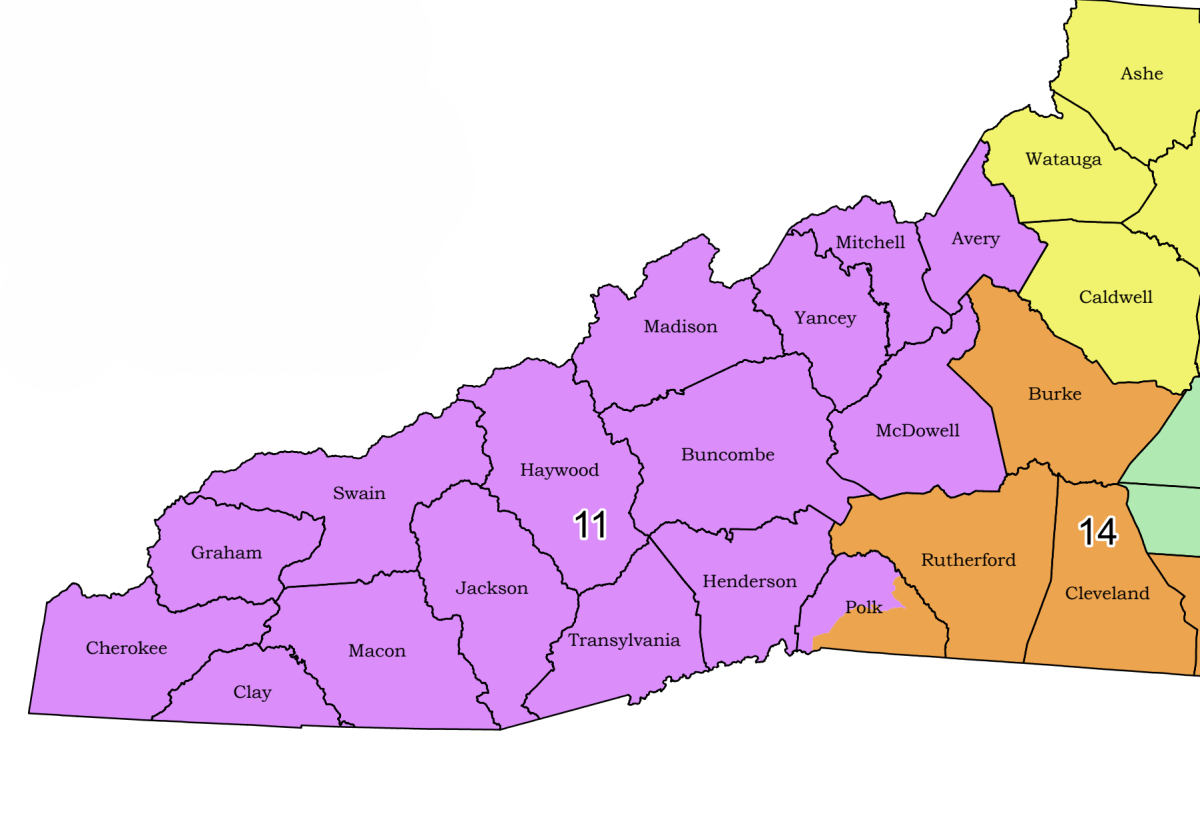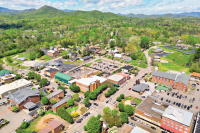New NC electoral maps just more of the same for the west
 One of two proposed congressional maps will probably be enacted by the General Assembly next week.
NCGA photo
One of two proposed congressional maps will probably be enacted by the General Assembly next week.
NCGA photo
Newly empowered General Assembly Republicans aren’t even trying to hide the fact that the congressional and legislative maps they drew behind closed doors and without substantive public input will disenfranchise Democratic voters across the state — especially in Congress.
“These maps are detrimental to fair representation across the state for not only communities of color but also young people and people in rural areas who don’t want their counties split,” said Anderson Clayton, chair of the North Carolina Democratic Party. “They don’t want Republican legislators picking their own voters.”
This most recent round of redistricting is not the first time North Carolina’s ruling party has attempted to squeeze more Republican seats out of a state that’s split nearly 50/50 among its two major parties.
In the 2020 General Election, Republican presidential candidate Donald Trump won the state by 1.34%. Republican state Supreme Court Chief Justice candidate Paul Newby beat Democrat Cheri Beasley by 401 votes out of 5,391,501 ballots cast. Democrat Roy Cooper won his second term as governor by 4.51%.
In the 2022 General Election, three Republican state Supreme Court candidates won their races by 4.78%, 4.38% and 2.42%. Republican Ted Budd won a U.S. Senate seat over Beasley by 3.23%. During voting for the state’s 14 congressional seats, Republicans came away with a statewide total of 1,956,906 votes, while Democrats notched 1,795,170 votes.
That showing gave Republicans 52.2% of congressional votes cast that year, which should translate to winning 7.3 of the 14 congressional seats. Republicans ended up with seven.
Related Items
The Democratic total of 47.8% extrapolates to winning 6.7 of the 14 congressional seats, which is exactly what they did, also scoring seven.
Those maps, however, were court-ordered — the result of what the Democrat-majority state Supreme Court called unconstitutional partisan gerrymandering by Republicans who drew unfair maps in 2021.
When the court flipped to Republican control, justices rushed to “re-hear” the maps case, and determined that partisan gerrymandering was not, in fact, unconstitutional.
THE LINES
New maps, dropped by the General Assembly on Oct. 18, embrace that ruling wholeheartedly. Two proposed congressional maps produce basically the same result.
According to data based on Trump’s 2020 General Election performance and compiled by Western Carolina University Professor Chris Cooper, the first map, coming from Senate Bill 756, produces an 11-3 Republican advantage. The second map, from SB 757, would result in a 10-3 Republican advantage, with one congressional district leaning Democrat by a single percentage point.
In either case, Western North Carolina’s 11th Congressional District wouldn’t change much at all, numbers-wise. Both maps would take the 11th from 55% Republican to 56% Republican.
The SB 756 map adds Avery and Mitchell counties to the 11th, while removing a small portion of southeast Buncombe County and the half of Rutherford County that had been in the 11th. The SB 757 map also adds Avery and Mitchell counties, while removing the half of Rutherford County that had been in the 11th and the eastern half of Polk County.
The NC-11 seat is currently held by Republican Chuck Edwards (R-Henderson) who actually underperformed against Asheville Democrat Jasmine Beach-Ferrara in 2022, winning with 53.8% of the vote to Beach-Ferrara’s 44.5%; Libertarian David Coatney earned 1.7%.
Katie Dean, chair of the North Carolina Democratic Party’s 11th Congressional District, thinks it’s too early to tell if the new maps will make candidate recruiting easier or harder, but she has already heard from some potential 2024 candidates.
“The competitiveness of NC-11 at large has not significantly changed, but I’ve had a number of people who are thinking of running reach out to me prior to the maps being released,” she said. “They really want to step up and pull the cloak off Chuck Edwards and his policies. Edwards ran as a moderate, but he’s openly courting Oath Keepers and the more extreme wing of the party in Western North Carolina, and has voted multiple times for a [House] Speaker [candidate, Rep. Jim Jordan of Ohio] who tried to overturn our democratic republic.”
North Carolina’s delegation in the U.S. House of Representatives is currently split seven to seven. Once the new maps are adopted, that could mean a net loss for Democrats of three or four seats. As Republicans currently hold a nine-seat advantage in the House, the new maps would make it tougher for Dems to reclaim the majority.
But that may not exactly be the case. In Illinois and New York, the same arguments are being used by Democrats to disenfranchise Republican voters. That could negate partisan plays by Republicans in North Carolina, stacking ballots in other states with Democrats and making it harder for Republicans to maintain control of the House.
“It's almost like, it's the power that corrupts absolutely, and not the party,” Cooper said.
On the state level, Cooper’s data shows that most legislators in the far west will see little to no changes to their districts.
In 2020, the 50th Senate District represented by Sen. Kevin Corbin (R-Macon) included seven whole counties — Cherokee, Clay, Graham, Haywood, Jackson, Macon and Swain. After the 2022 redraw, Transylvania County was added in, while a chunk of northeastern Haywood County was taken out and added to the 47th District, represented by Mitchell County Republican Sen. Ralph Hise.
The new 50th District map is almost identical to the old one but for four precincts — White Oak, Fines Creek 2, Beaverdam 5/6 and Beaverdam 7, which will be returned to Corbin’s 50th.
In all practicality, the change means little; Corbin committed to addressing the concerns of Haywood County residents whether they live in his 50th District or not, and Hise used his considerable sway to ensure Corbin and Haywood got what they needed to deal with devastating floods in 2021 and the closing of the Pactiv Evergreen paper mill in Canton earlier this year.
Cooper’s data shows that Corbin’s “new” district is four-tenths of one percent more Republican than his old one. Again, the change matters little. Corbin won both of his Senate elections with more than 66% of the vote.
The other 49 senatorial districts drawn by Republicans could at best net them two more seats in addition to the 30 they already enjoy, says Cooper.
Western House Reps. Karl Gillespie (R-Macon), Mike Clampitt (R-Swain) and Mark Pless (R-Haywood) will see no changes to their current districts. Gillespie’s 120th remains 74.2% Republican, Clampitt’s 119th weighs in at 56.6% and Pless is still at 63.3%.
Asheville, however, is a different story. Buncombe County’s three House districts were renumbered and rejiggered, which could cost Democrats a seat there.
Caleb Rudow’s new district is only 20.1% Republican and Eric Ager’s weighs in at 44.1% Republican, but first-term incumbent Lindsey Prather’s new district will give her a tough reelection fight in 2024, at 54.1% Republican.
Republicans already claim 72 of the chamber’s 120 seats. The new maps could net them anywhere from zero to five additional seats. So long as there are no surprises on Election Day in 2024, the NCGOP looks to be a lock to retain or expand the veto-proof supermajority that currently exists.
“Though these maps were drawn through a secretive and purely partisan process, they were no surprise,” Prather said. “The Republican supermajority drew the best maps they could to keep themselves in the supermajority, regardless of voters’ wishes, which is exactly what we figured they would do. Buncombe County outside of Asheville has been steadily trending blue, yet this map blatantly attempts to carve out a Republican seat where one doesn’t belong.”
THE LAWSUITS
It wouldn’t be redistricting in North Carolina without the threat of lawsuits looming. The Associated Press says that every round of remapping in North Carolina since the 1980s has
been challenged in courts.
“The question is, if people sue, are they going to be trying to sue to block for 2024 or are they just going wait it out until 2026?” Cooper said.
The filing period for the March 5, 2024 Primary Elections begins on Dec. 4 of this year. That doesn’t leave a lot of time for litigating and possibly redrawing the proposed maps.
If there is a suit, it’ll likely involve only the congressional map. Where the suit ends up depends on what issue the plaintiffs raise.
If it’s a partisan question alleging violations of the state constitution, it would go to the state Supreme Court and likely fail in the face a predetermined partisan outcome.
If it’s a racial question alleging violations of the Voting Rights Act of 1965, it would go to federal district court.
Enacted by President Lyndon Johnson to protect the voting rights of racial minorities in the South, the VRA has seen substantial revision by the U.S. Supreme Court in recent years, although section 2, which deals with racial discrimination, remains.
Any such suit would likely center on the 1st Congressional District represented by Donald Davis, one of only three Black reps from North Carolina. The largest racial group in Davis’ district is Black.
“The federal courts have been a little bit reticent on partisan questions lately, but they have been surprisingly eager to rule with plaintiffs based on arguments about race,” Cooper said.
In January, a three judge-panel unanimously ruled South Carolina’s congressional map unconstitutional because it intentionally discriminated against Black people. The case was heard in the Supreme Court earlier this month.
Last month, SCOTUS ruled against Alabama’s assertion that it would draw a map with only one Black-majority district instead of two.
North Carolina has an unfortunate recent history with racial gerrymandering.
In May 2017, the Supreme Court struck down a congressional map after an appeals court had ruled that it targeted Black populations for disenfranchisement “with almost surgical precision.”
The new proposed House maps are scheduled for a vote in Raleigh on Monday. The Senate and congressional maps will likely follow in the coming days.
If duly adopted and unchallenged in court, the new maps will remain in effect through the 2030 election. Clayton said she “definitely” thinks the maps will be challenged.
NCGOP Chair Michael Whatley didn’t respond to an email requesting comment on this story.









